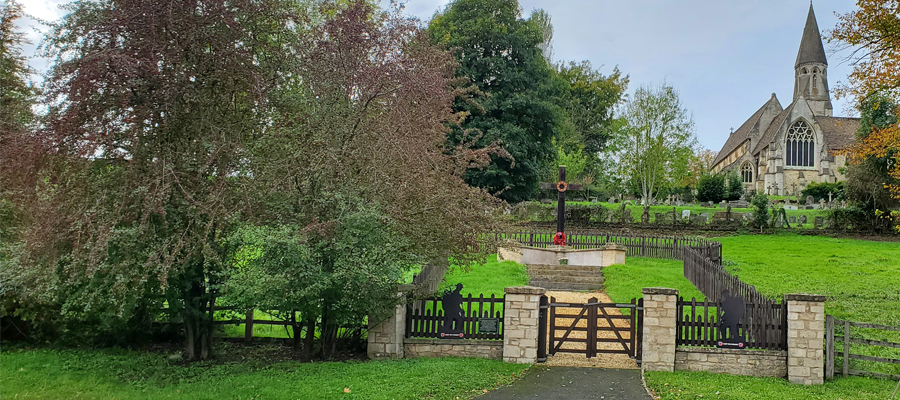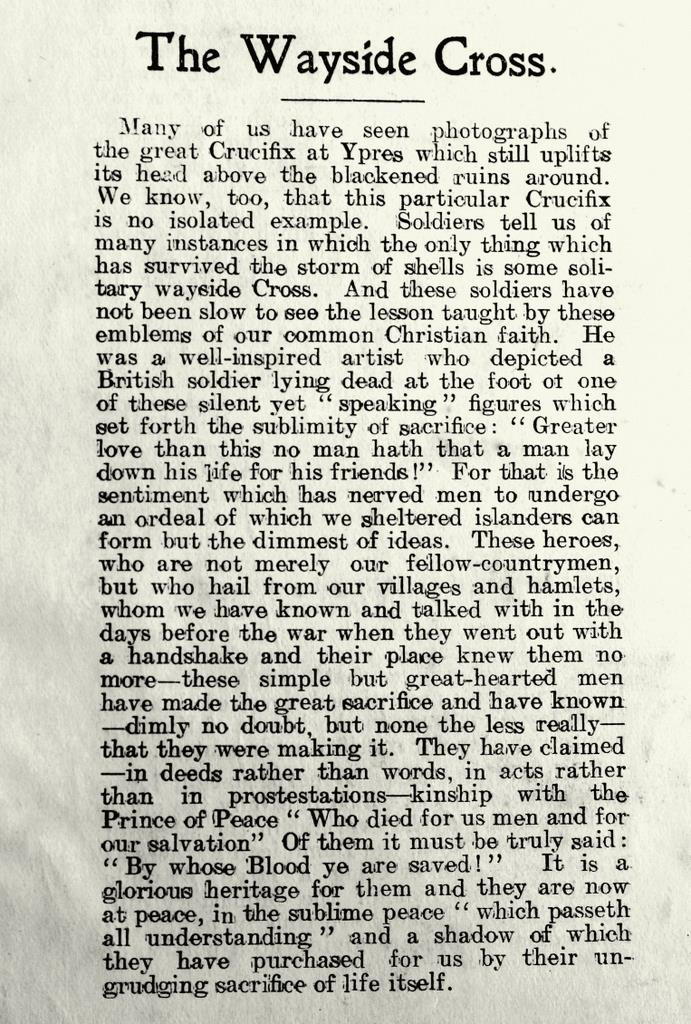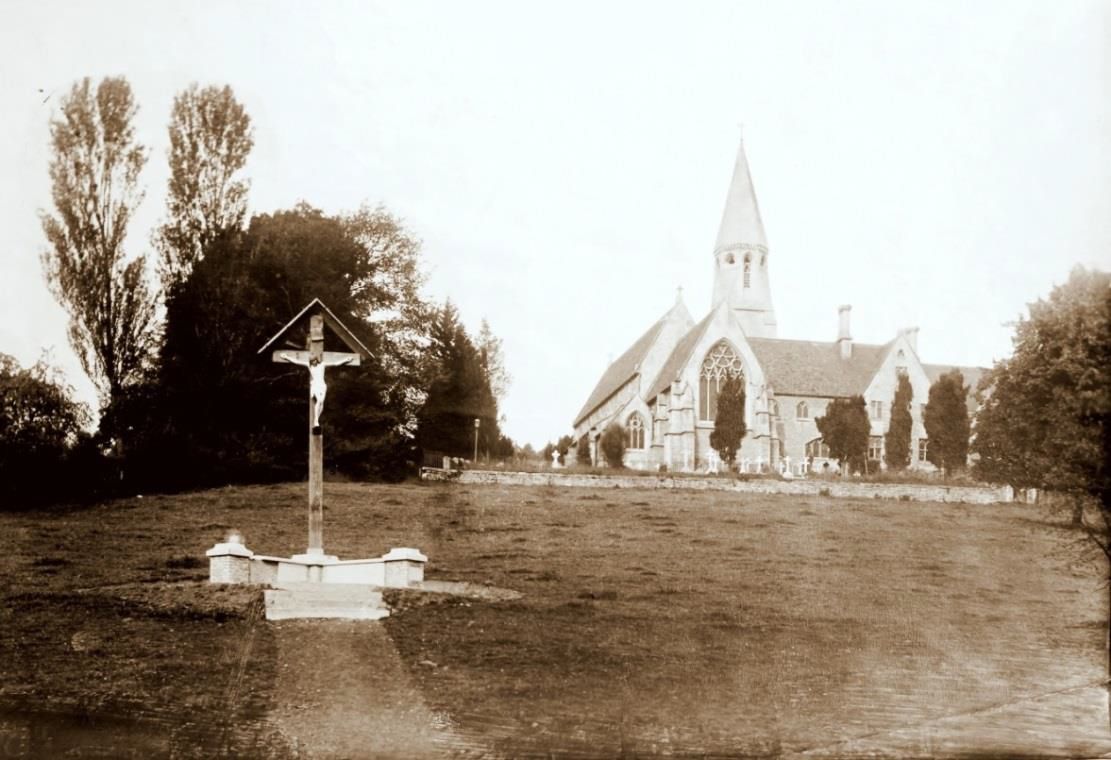1914 - 1918
Two events happened in 1914 leading to its construction. Firstly a new Prior, Father Hugh Pope, was appointed to the Dominicans at Woodchester. He led the novices, the ordained and the lay members of the community. Secondly a shot was fired in Sarajevo which led to the enlistment of hundreds of Stroud men, including several members of the Priory, to fight for King and country. Father Pope gave sermons outlining the plight of occupied Belgium and encouraging men to enlist to fight in the cause of justice and freedom. From August 1914 they

began to be brought home injured or dead. In 1914 there was shock that a single shot could lead to such sacrifice; in 1915 the horror grew as it became apparent that the war would not be over soon, and that the stalemate of the trenches of the Western Front would continue to bring news of escalating casualties. Father Pope was very aware of the grief felt by him and the people of the Stroud Valleys. Many were members of his congregation.
The idea to build a monument to pay tribute to those who had sacrificed their lives in the Great War was first conceived by the Prior, influenced by his parishioners, including Lady Mostyn of Benwell House who had lost her nephew Maurice Dease in August 1914, the first V.C. of the war. Perhaps it was the loss in October 1914 of George Archer Shee, another parishioner; or the loss of Jack Quinn, the fostered garden boy at the Priory, who had been so keen to enlist, but who had been killed aged just 20.

“The idea of setting up a big cross in memory of those who had fallen in the war was first thrown out towards the end of 1915. At first it was intended merely for those who were members of the congregation at the Monastery Church. But it as soon felt that this idea would make a far wider appeal than was at first anticipated. For men of all classes and faiths had fallen. Those who mourned their loss and realised the immensity of the sacrifice made by these men and by those who gave them for the cause of freedom and humanity were anxious to have their names perpetuated.”
October/November 1915 would have been the first anniversary of the death of George Archer-Shee, who was the subject of Terence Rattigan’s play The Winslow Boy. His father, Martin Archer-Shee was a prominent member of the congregation and we may assume that he was instrumental inthe wish for a memorial. Father Pope, however, felt it would be too exclusive to restrict such a memorial to the Fallen of his parish. He had genuine sympathy for all the grieving families in the Stroud district, “his neighbours”, and wanted to extend the availability of a memorial to all who had lost someone, rich and poor, “for all classes and creeds”. As he wrote in his proposal issued in early 1916:
“These heroes…..who hail from our villages and hamlets, whom we have known and talked with in the days before the war when they went out with a handshake and their place knew them no more—-these simple but great hearted men have made the great sacrificeand have known that they were making it. They have claimed kinship with the Prince of Peace.”
It was a picture of a forlorn soldier sitting at the base of a Wayside Cross in a devastated French town that inspired him to want similar as a memorial in Stroud. . He was inspired by the soldier’s picture and the message of redemption it implied, a symbol of both Christ’s sacrifice and the redemption afforded by that sacrifice. Although adjacent to their Priory and planned by their Prior, it did become a monument for all. People gave subscriptions generously. The grieving did not have to subscribe; they had only to make the request and the name would be added. There were no other memorials in the country for people to honour their men and to have remembrance. At the end of the war Father Pope thought that there would be about 150 names. Eventually 140 names were inscribed on twelve Portland stone plaques.
Donations were asked for in the spring of 1916. On July 4th he wrote that two people in particular had been generous; Mr Workman, who owned the wood yard in Woodchester and several of whose workers, including Walter Fruin, were killed in the war, provided the wood. Mr Brown who today owns the same wood yard has given the wood for the restoration. Mr Leigh who owned Woodchester mansion provided the stone. Father Pope had a budget and the plan was formalised. He writes on July 28th 1916 that the requisite £100 had been already collected and that the work had been put in the hands of the sculptor. Did they start work soon after that? I think we can safely date the start of the memorial to July or August 1916. Prior Pope expected the Cross to be completed quickly but found that so many sculptors were at the Front that delays became inevitable. Father Pope drew up a design but was unhappy with it. Mr Falconer of Amberley, an experienced architect, told him that if he needed help to “knock on his door” and it is his design that we see today.
Father Pope’s plan brought immediate reaction. Several letters were written to the Stroud News, particularly from the vicars of Woodchester and Stroud, who saw the new memorial as a Catholic monument, disliked the public exposure of the figure of Christ and saw the building of a memorial in a public place as their prerogative. They saw the matter as coming under their domain. There was great rivalry and perhaps some bigotry involved in some of the letters published in The Stroud News. This view was not shared by any other correspondents such as the minister for Nailsworth, Rev. Frank Smythe, or “A Soldier”, writing to the newspaper from the trenches, who saw it as entirely appropriate to honour those who had made the ultimate sacrifice with a depiction of Christ. The objections were overcome by general support from the people of Stroud who wanted it and were encouraged in their support by the news that several of the Dominican community were fighting for England in the trenches of France.

The Wayside Cross in early 1917
The prior gave a sizeable strip of the meadows bordering the road that was later to be the A46, and in May 1917 Messrs Newman and Hender straightened and greatly widened the road to accommodate the hundreds expected to attend the dedication ceremony on June 3rd 1917. In the event, 2-3000 came to hear the dedication by the Archbishop of Clifton and to lay flowers on the Cross. On the day the life size figure of Christ coming from London by train never arrived. At the last hour the Prior ordered that another figure that had been given to the Priory by William Gladstone’s sister some years previously was to be a substitute, and the ceremony went ahead.
